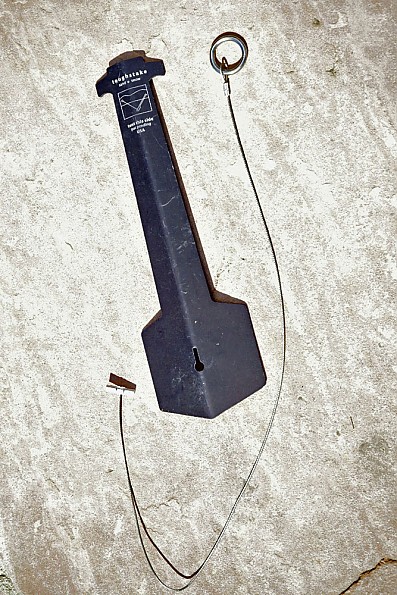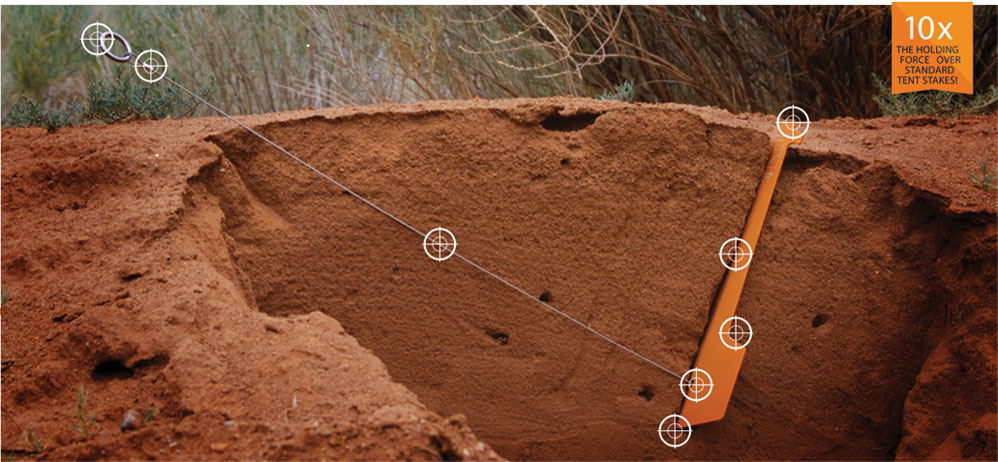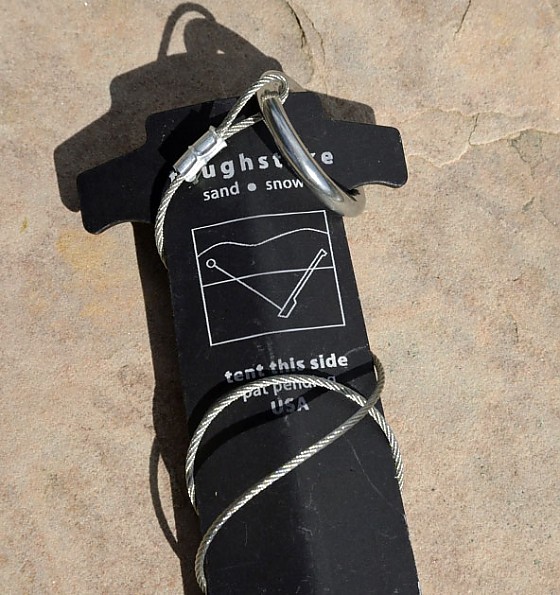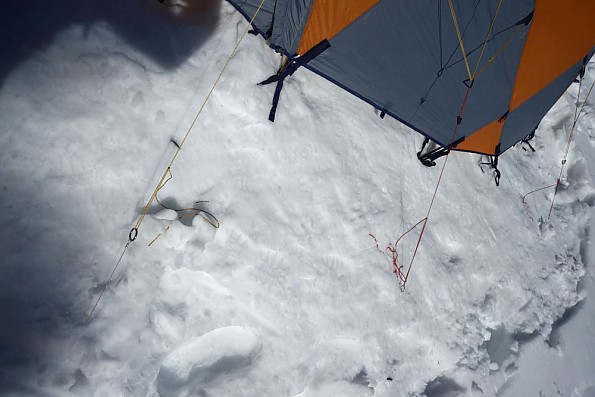Toughstake Large Toughstake
Toughstake is no longer in business, and the Large Toughstake has been discontinued. The Toughstake Large Toughstake was renamed and is now called the MSR ToughStake.

Toughstakes were designed for use in snow, sand, and other loose ground. They worked very well in my tests in snow. Anchoring a tent in an area of high winds is a problem encountered by most backpackers and virtually all high-altitude, winter, and polar expeditions. There are many solutions, some more satisfactory than others.
I have not seen the Toughstakes in stores. But they can be ordered online from http://www.toughstake.com/
Pros
- Hold very well in soft snow and windy conditions
- Easy to place and easy to remove in snow or sand
Cons
- Expensive
- Heavy, especially for a full set needed for expedition tents
All tents should be anchored when pitched, perhaps “free-standing” ones most of all. Although I have not personally experienced a tent blowing away, I have witnessed many unanchored flying tents and tarps, including one during a winter camping course I was teaching that traveled over a quarter mile before being retrieved and one that ended on top of my tent and a neighboring one.
The most difficult situation is on ground that is hard, such as a rock shelf, with soft snow or sand being close behind. Hard ground requires finding heavy rocks, logs, or well-established trees. Soft ground requires huge stakes, “deadmen”, “parachutes”, or bags filled with the sand or snow. Simply putting your pack and other gear in the tent is really inadequate, sometimes resulting in the tent getting blown away with its contents (sometimes including the occupants, as I witnessed on Denali).
Details
Those of us who do a lot of winter camping or go on expeditions to high altitudes have to deal with situations that are less than ideal for pitching our tents. The surface may be soft snow (powdery or slushy). We do not often encounter sand, but the stake-down problems are similar. The tent stakes supplied even with the most expensive tents are inadequate in those situations
A number of solutions are used. So-called “snow stakes” are sold in REI, MEC, and specialty mountaineering stores. These are simply standard U-shaped stakes, a bit longer than the common U-stakes, with holes to lighten them. Unfortunately, these stakes are weak and often get bent when pounding them into the firmer soil of National Park campgrounds.
Another solution is to use improvised “snow anchors” in the form of plastic or cloth bags stuffed with snow, attached to the tent with cord, and buried in the snow. It is common for these to get frozen in the snow, leading to the cord simply being cut, so that the detritus of torn bags reappears in spring when the snow melts.
A variation on this is the “parachute” or wooden square. The “parachute” is a square of cloth that gets buried in the snow arranged so that it traps a large amount of snow if pulled on. The wooden square is simply a 4 inch square of thin plywood, with a hole drilled in the center to attach a cord, which is then attached to the tent’s stake loops and guylines. These also often get frozen into the snow overnight or after a few days in a basecamp, hence getting abandoned.
The “deadman” is often a branch or stick that is tied to the guy line attached crosswise in the stick’s middle, then buried in the snow. Since the stick is usually found locally, it is often just cut loose when abandoning camp. This still leaves the abandoned cord as detritus. In areas above timberline, the deadman may be a standard tent stake, either singly or two stakes buried crosswise in the form of an “X”.
While climbers will go to great lengths to retrieve the tent stakes (because of both cost and the limited supply for the next campsite), recovery often requires a large amount of effort, which is unwelcome at higher altitudes.
Since high altitude climbers often carry pickets or flukes for use as anchors, these can be used when in camp. Obviously, other arrangements must be made during periods that climbers are up the mountain using the pickets and flukes as anchors.
In areas where stakes can not be placed , you may be able to find suitable rocks or other natural objects to which the tent guy lines can be fastened.
I first encountered the Toughstake company at the Outdoor Retailer Show a few years back. The basic design resembles a snow fluke with a T-handle attached at the top. Instead of the looped cable of a fluke, the Toughstake has a keyed slot in the middle of the “fluke-like” section, through which is threaded a single thin steel cable with a steel ring at one end and a small crosspiece at the other. The cable is inserted with the crosspiece in the keyhole-shaped slot, with the cable being pulled so it is straight. The ring serves as the attachment point for the tent’s guy line, while the crosspiece transfers to load to the “fluke”.
The Toughstake is placed in the snow or sand with the top slanted away from the direction of pull and the “V” shape of the “fluke” pointed in the direction of pull (just as with a snow fluke anchor), so that the pull on the cable causes the stake to be forced further into the snowpack or sand.
The following picture, found on the Toughstake website, illustrates the principle.
For the stake loops found at the corners of most tents and rainflies, the Toughstake is placed in the same way as a normal tentstake, with the crosspiece of the “T” at the top serving to hold the loop.
The prices of the Toughstakes are fairly expensive. The MSRP for the small aluminum is $24.99 for 4-pack; for the medium aluminum is $34.99 for 2-pack, and for the large aluminum $39.99 ea for painted (the steel versions cost more - $59.99 for the medium 2-pack and $69.99 for a single large).
I found the small aluminum plenty strong enough for all the situations I tested in (3-man Mountain Hardwear Trango 3.1 in soft powder and mushy snow, winds in a couple cases measured a sustained 35 knots for several hours
Details of testing
When I first viewed the Toughstake at their OR Show booth, they were demonstrating with a sandbox. I was a bit skeptical, especially when I first shoved one of the stakes into the sand, tugged the cable, and found the stake pulled out.
For very loose sand, the technique is to push the stake into the sand a short distance, then use a mallet or rock to drive it in to the top of the “T”. This causes the sand grains to align and settle, producing an astoundingly firm anchor. I had also noted that the Toughstakes seemed inordinately heavy, adding a large amount to already heavy expedition packloads.
At the third OR Show, when I stopped by the Toughstake booth and still expressed some skepticism, the designer (who bears the name of a famous climber who I know, but is no relation) offered to loan me a set of the stakes for more extensive testing, on the condition that I let him know what I found (basically “beta testing”).
The set was all the aluminum version and included 2 medium and 11 small stakes (3 of the small stakes were prototypes colored a copper tone). This is the number needed to fully stake out and guy my Trango 3.1. The large stakes are intended more for large tents, tarps, and sunshades, which present a much larger wind cross section.
One of the first things I did was to measure the weights of the Toughstakes and other, more traditional anchors. Since most of the stakes are individually very light, I measured groups of at least 2, and up to 10 for the lightest ones to get more accurate individual weights. The table below summarizes the individual stake weights:
SMC snow stakes – 1 oz/ 28 grams
Black Diamond heavy duty “T” – 2.2 oz / 61 grams
Campmor “parachute” – 1.2 oz/32 grams
Hilleberg DAC (with Soulo tent) – 0.4 oz /11.6 grams
Mountain Hardwear (with Trango 3.1) – 0.5 oz/ 13.9 grams
Toughstake medium – 5.3 oz/152.5 grams
Toughstake small – 1.8 oz/ 39 grams
Fully staking and guying my Mountain Hardwear Trango 3.1 with its fly (a 3-person expedition tent with a generous front vestibule and a smaller rear vestibule) for a serious blizzard at altitude requires 11 anchor points (several sets of the side guy points can be grouped).
A full set of the small Toughstakes adds up to about 20 oz/1 ¼ pounds/429 grams. Compare that to 11 oz/308 grams for the traditional SMC snowstakes or 5.5 oz/0.34 pounds/153 grams for the pegs that Mountain Hardwear supplies with the Trango 3.1.
During my usage of the Toughstakes, I recorded a maximum sustained wind speed of 35 knots, not a severe test. While I had no problems with tents blowing out of their Toughstake anchors, I also had no evidence of the anchoring giving way. On the other hand, I have used a Trango 3.1 in Antarctica in steady winds of 50 knots and a few gusts up to 60 knots, using the standard stakes as deadmen.
Placement of the Toughstake is readily accomplished in most snow by just shoving it in with a slight backtilt, the point of the “V” surface pointing in the direction of pull, just as with a fluke. In firm snow, you cut a slot from the stake toward the tent, so it aligns with the guy line (same manner as in placing a deadman or the cables in anchoring a fluke). A diagram on each stake shows the proper alignment of stake and cable. (Note – for carrying and storage, I found it convenient to wrap the cable around the stake and hook the ring on the “T”).
In very soft snow, it is necessary to pack the snow to make it somewhat more firm. In practice in the field, I found that stomping out a tent platform with skis or snowshoes out to where you would place the stakes provided plenty of holding power, even in very dry snow as found at subzero temperatures. In mushy snow in temperatures near freezing, the Toughstakes would freeze in place readily.
Removal of the Toughstakes is usually much easier than with traditional snowstakes or deadmen. The cable provides a way to provide a pulling force along the length of the stake, sliding it back out of its hole. In cases where the snow had turned into solid ice during a prolonged basecamp stay, I resorted to using an ice ax to loosen the stake. Since the cable is steel and the stake itself metal, I did not have to use too much force on the ax to remove the stake in fairly short order, far more quickly than deadmen or other anchoring methods.
The photo shows a corner of my Trango 3.1 with the Toughstakes on 3 of the guy lines.
I pitched tents using the Toughstakes a number of times in snow during the Winter Camping course I initiated some 20 years ago and still participate in as an instructor, on backcountry ski and snowshoe trips, and during a backcountry trip to an ice climbing area in the Sierra. During two of the trips we had fairly soft snow conditions.
Because the winds were only moderate during any of the trips, I tried pulling the stakes out by attaching a line to some fully set stakes and pulling in the direction that a tent in the wind would pull, in one case with the help of another of the instructors. We were unable to pull the stake out, although applying the force along the axis of the stake removed it fairly easily.
During the numerous placements and extractions of the Toughstakes, the surface coating remained intact with no scratch marks of abrasion to the bare aluminum, and none of the stakes got bent. Most other stakes I have used, whether the “coathanger wire” or shaped , bend sooner or later, notably the U-shaped “snow stakes”. The only exception I have found of a reasonable weight are the Black Diamond heavy “T” stakes. I did exert a lot of force extracting some of the well frozen-in Toughstakes, along with chopping several out with an ice ax. Based on my experience, I would recommend the Toughstakes for heavy-duty use.
Another consideration in buying tent stakes or other tent anchoring system is the cost. The traditional SMC stakes sell for about $3 each in outdoor stores, adding up to $35-$40 for a set for an expedition tent. MSR Groundhogs sell for $2.50 each, while the similar (but sturdier) stakes were included with my Trango 3.1 and with my Hilleberg Suolo. Compare this to the cost of 3 packs of 4 small Toughstakes at $75 plus shipping. You can, of course, argue that $75 is a small price for the insurance that the Toughstakes offer, though on an expedition presenting that kind of anchoring requirement, you are likely to be carrying pickets, flukes, ice axes, skis, and snowshoes which can be used to anchor the tents.
Conclusions
The Toughstakes live up to their intended solid anchoring of tents in soft snow and sand. If you are going to a location where you will be camping in soft (powder or slush) snow conditions and high winds, the Toughstakes are worth considering. The strong holding power must be weighed against the extra weight and cost, versus the more traditional approaches of using the gear you carry with you anyway (but might be needed on the mountain while you are away from base camp) or one of the “deadman” variations that have been used for years. Since I did no field tests in sand, I have no recommendation in that application, except to note that in the “sandbox” test, the stakes seemed to hold quite well.
As a final thought, although I did not test this idea to determine how well, if at all, it would work — pickets and flukes are heavy and sizable. Maybe Toughstakes, particularly the large size, could be adequate as snow anchors for climbing steep snow slopes or on glaciers. A lot of testing to determine optimal placement would have to be done.
In addition, multiple placements would be needed to build an anchor system in loose snow (just as with cams and chocks). If you try this idea, you do so completely at your own risk. I would be sure that Toughstake would thoroughly disapprove of even the mere mention.
Source: tested or reviewed it for the manufacturer (on temporary loan, to be returned)
Does not work in dirt, way too expensive, waste of time and money.
Pros
- Works in sand and snow
Cons
- Expensive
- Doesn't work in dirt
- Bends way too easily
Takes way too long to put into the ground. I am an experienced camper and the Toughstake was just like any other stake that I have used. I blew my money on this thing and I hope that it stops you from making the same mistake that I did. I made a homemade bowl stake and it worked 100% better.
Source: bought it used
Sucks.
Pros
- Nothing
Cons
- Everything
All awful. Never waste the money.
Source: bought it new
Price Paid: $40
Your Review
You May Like
The Large Toughstake has been renamed. It is now known as the MSR ToughStake.
Specs
| Price |
MSRP: $39.99 Historic Range: $27.95-$39.99 Reviewers Paid: $40.00 |
| Weight |
7 oz / 198 g |
| Length |
17.5 in / 44.45 cm |










